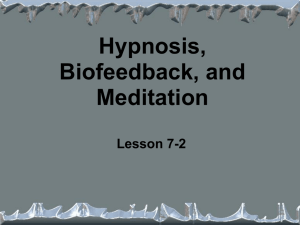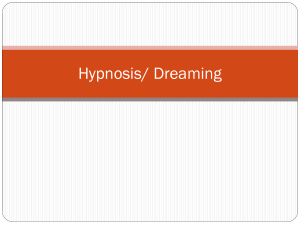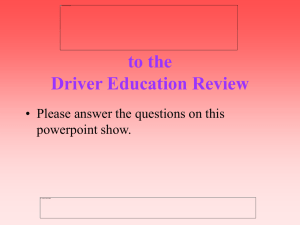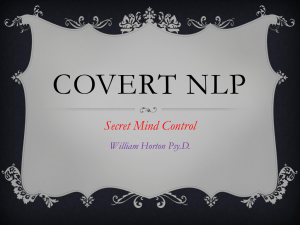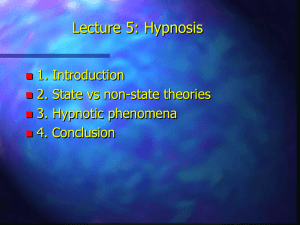Ericksonian Hypnosis - Youth In Need - St. Peters
advertisement
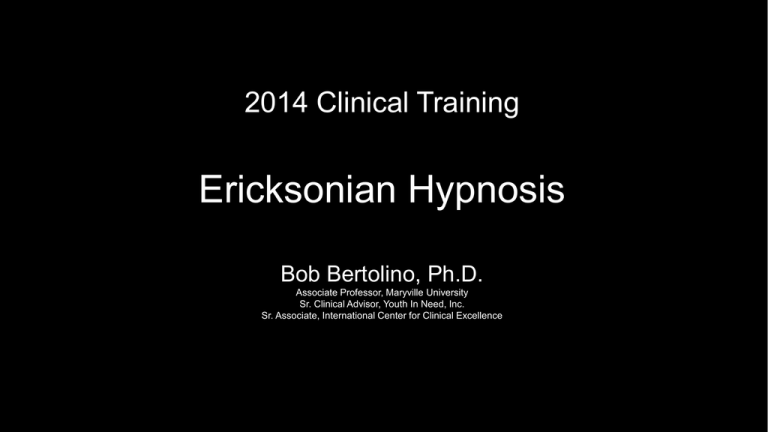
2014 Clinical Training Ericksonian Hypnosis Bob Bertolino, Ph.D. Associate Professor, Maryville University Sr. Clinical Advisor, Youth In Need, Inc. Sr. Associate, International Center for Clinical Excellence Tidbits • • • • For copyright reasons and confidentiality some of PowerPoint slides may be absent from your handouts. To download a PDF of this presentation, please go to: www.bobbertolino.com. Please share the ideas from this presentation. You have permission to reproduce the handouts. I only ask that you maintain the integrity of the content. Contact: bertolinob@cs.com; +01.314.852.7274 bobbertolino.com Hypnosis Defined Former (Pre-2003) Definition of Hypnosis “Hypnosis is a procedure during which a health professional or researcher suggests that a client, patient, or subject experience changes in sensation, perceptions, thoughts or behavior.” APA, Division 30, Society of Psychological Hypnosis. Revised Definition of Hypnosis “A focused experience of attentional absorption that invites people to respond experientially on multiple levels to amplify and utilize their personal resources in a goal-directed fashion.” (p. 7). Yapko, M. D. (2012). Trancework: An introduction to the practice of clinical hypnosis (4th ed.). New York: Routledge. Hypnosis Redefined “Hypnosis is a procedure during which a health professional or researcher suggests that a client, patient, or subject experience changes in sensation, perceptions, thoughts or behavior.” “A focused experience of attentional absorption that invites people to respond experientially on multiple levels to amplify and utilize their personal resources in a goal-directed fashion.” In hypnosis, people process information differently, and they are able to access abilities they otherwise don’t know how to elicit. Thus, you have to ask yourself what you believe about people and their innate abilities Do you believe people have more resources than they consciously realize? From Pathology to Strengths “What we have learned over 50 years is that the disease model does not move us closer to the prevention of these serious problems. Indeed the major strides in prevention have largely come from a perspective focused on systematically building competency, not correcting weakness. Prevention researchers have discovered that there are human strengths that act as buffers against mental illness: courage, futuremindedness, optimism, interpersonal skill, faith, work ethic, hope, honesty, perseverance, the capacity for flow and insight, to name several. Much of the task of prevention in this new century will be to create a science of human strength whose mission will be to understand and learn how to foster these virtues in young people. Working exclusively on personal weakness and on the damaged brains, however, has rendered science poorly equipped to do effective prevention. We need now to call for massive research on human strength and virtue. We need to ask practitioners to recognize that much of the best work they already do in the consulting room is to amplify strengths rather than repair the weaknesses of their clients.” (p. 6-7) Seligman, M. E. P., & Csikszentmihalyi, M. (2000). Positive psychology: An introduction. American Psychologist, 55(1), 5–14. Defining Strengths-Based A strengths-based perspective emphasizes the abilities and resources people have within themselves and their support systems to more effectively cope with life challenges. When combined with new experiences, understandings and skills, those abilities and resources contribute to improved well-being, which is comprised of three areas of functioning: individual, interpersonal relationships, and social role. Strengths-based practitioners value relationships convey this through respectful, culturally-sensitive, collaborative, practices that support, encourage and empower. Routine and ongoing real-time feedback is used to maintain a responsive, consumer-driven climate to ensure the greatest benefit of services. Bertolino, B. (2014). Thriving on the front lines: Strengths-based youth care work. New York: Routledge. Strengths-Based Principles 1. Clients are the most important contributors to service success. 2. The therapeutic relationship makes substantial and consistent contributions to outcome. 3. Culture influences and shapes all aspects of clients’ lives. 4. Effective services promote growth, development, and well-being. 5. Expectancy and hope are catalysts of change. Hypnosis Historically Historical Background • At the start of the 20th century there were two primary schools of thought about hypnosis, both originating in France. • Jean-Martin Charcot (Salpêtrière Hospital) who proposed the magnetism model—based on Franz Mesmer’s notion that trance was the result of the “Mesmerist” transferring magnetic energy to patients either directly or indirectly through inanimate objects. • The Nancy School, headed by Hippolyte Bernheim. • Freud studied under Charcot, then later with Bernheim. • Bernheim ultimately disproved the magnetism model, famously stating in 1882, “There is no hypnosis, only suggestion.” • Bernheim’s influence in Freud was substantial. Historical Background (cont.) • James Braid is credited with coining the term “hypnosis,” and made the distinction that Mesmerism was done to someone whereas hypnosis was done with someone. • Clark Hull, an early learning theorist, was the first to establish sophisticated protocols for conducting experimentation with hypnosis in the early 20th century (described in his classic 1933 text, Hypnosis and Suggestibility). • Many aspects of Hull’s original research protocols continue to be used in current experimental paradigms. • Hull was a significant influence many innovators of hypnosis, including Milton Erickson. Credentialing • In the US hypnosis is viewed as a specialized approach or method • There are several certifying bodies (ASCH, NBCCH), however, certification is not required in the US (several countries do require certification) • Hypnosis written into YIN’s COA policies as an alternative practice • Best practice always includes: • Regarding Clients: Informed-consent, discussion of benefits and risks, disclosure of experience level • Regarding Practice: Training, ongoing supervision, ethical practice and decisionmaking Milton H. Erickson, M.D. Milton H. Erickson, M.D. (1901-1980) • Two bouts with polio, nearly died at 17 • Used autohypnosis to regain use of muscles and movement • Experienced substantial pain throughout his life • Had dyslexia and color-blindness • Trained as a psychiatrist • Made many seminal contributions to psychiatry and psychology including a nonpathological approach, permissiveness, inclusion, and utilization Perhaps Milton Erickson’s most significant contribution was in developing an interpersonal view of hypnosis. Why Learn Hypnosis? Why Learn Hypnosis? • Empirical evidence it works (i.e., hypnosis objectively enhances treatment outcomes). It is an Evidence-Based Practice (EBP). • The International Journal of Clinical and Experimental Hypnosis published two special issues back-to-back in 20007 summarizing much of the current literature on the merits of hypnosis in treating pain, depression, anxiety, asthma, headaches, PTSD, and more. • All therapy involves the use of suggestion. Evidence-Based Practice (EBP) “The integration of the best available research with clinical expertise in the context of patient characteristics, culture, and preferences.” (p. 273) APA Presidential Task Force on Evidence-Based Practice. (2006). Evidence-based practice in psychology. American Psychologist, 61(4), 271–285. Clinical Expertise The APA Task Force on EBP “Clinical expertise… entails the monitoring of patient progress (and of changes in the patient’s circumstances—e.g., job loss, major illness) that may suggest the need to adjust treatment… If progress is not proceeding adequately, the psychologist alters or addresses problematic aspects of the treatment (e.g., problems in the therapeutic relationship or in the implementation of the goals of the treatment) as appropriate” (2006, pp. 280, 276-277). APA Presidential Task Force on Evidence-Based Practice. (2006). Evidence-based practice in psychology. American Psychologist, 61(4), 271–285. Lambert, M. J., Bergin, A. E., & Garfield, S. L. (2004). Introduction and overview. In M. J. Lambert (Ed.), Bergin & Garfield’s handbook of psychotherapy & behavior change (5th ed.)(pp. 3-15). New York: Wiley. Warren, J. S., Nelson, P. L., Mondragon, S. A., Baldwin, S. A., & Burlingame, G. A. (2010). Youth psychotherapy change trajectories and outcomes in usual care: Community mental health versus managed care settings. Journal of Consulting and Clinical Psychology, 78(2), 144-155. Patient (Client) Characteristics, Culture, and Preferences • • • • Client characteristics (i.e., age, gender, gender identity, ethnicity, race, social class, disability status, sexual orientation, developmental status, life stage, etc.). Strengths, resources, beliefs, and factors that can influence change. Understanding of the local knowledge and culture. Personal preferences, values, and preferences related to treatment (e.g., goals, beliefs, worldviews, treatment expectations). Why Learn Hypnosis? (cont.) • Provides insights into subjective experience. • Enhances one’s sense of personal control. • Multi-dimensional applications. • Enhances cognitive, behavioral, and emotional flexibility. • Hypnosis is now well-integrated into the fields of psychotherapy and behavioral medicine based on substantive empirical evidence for its efficacy. Is Hypnosis a Therapy? There are good arguments to both yes and no. My view is that hypnosis is a tool, an experiential vehicle for stimulating new, therapeutic associations in the client. Does Hypnosis Cure People? No. It’s what happens during hypnosis—the new and beneficial association the client forms. What Does Hypnosis Do? It amplifies and/or de-amplifies specific elements of experience. It generates associations and dissociations. Think in these terms: What frame of mind does someone need to be in in order to achieve the goal? Hypnosis is about building frames of mind. The Salient Question… Is not, “Does hypnosis cure problem X?” Rather, “If one applies therapy approach Y without hypnosis and applies therapy approach Y with hypnosis, will the addition of hypnosis to the process likely enhance the treatment outcome?” The evidence suggest the answer is yes. What Does Hypnosis Add to the Therapy Context? 1. Hypnosis amplifies aspects of personal experience and may make it easier to recognize how the client’s patterns of perception, thinking, interpersonal relating, etc. are contributing to distressing states; 2. Hypnosis stimulates experiential learning; 3. Hypnotic suggestion is an effective method of achieving pattern interruption; 4. Hypnosis helps to organize and contextualize desired responses; 5. Hypnosis encourages and models flexibility in perceptions and selfrelations; and 6. Hypnosis helps create focus. Contexts of Hypnosis • Medical • Dental • Forensic • Educational • Sports • Psychotherapeutic Jay Haley (1993-2007) “The influence of hypnosis upon all forms of therapy has not been fully appreciated. It can be argued that most therapeutic approaches have their origins in that art… Out of hypnotic training comes skill in observing people and the complex ways they communicate, skill in motivating people to follow directives, and skill in using one’s own words, intonations, and body movements to influence other people. Also out of hypnosis come a conception of people as changeable, and appreciation of the malleability of space and time, and specific ideas about how to direct people to become more autonomous.” (Haley, 1973) Haley, J. (1973). Uncommon therapy: The psychiatric techniques of Milton H. Erickson, M.D. New York: Norton. Hypnosis in Psychotherapy General Ways to Use Hypnosis 1. Symptom management strategies (e.g., enhancing sleep, reducing anxiety) 2. Skill-building/resource accessing (e.g., enhancing cognitive flexibility, building problem-solving skills) 3. De-framing and reframing (e.g., “It’s not you, it’s the way you go about it” 4. Association and dissociation (e.g., shifting focus away from feelings to action, shifting focus from past to future) Multiple Functions of Hypnosis • To explore consciousness • To explore spirituality • To delineate individual differences • To help people change • To heal disease or mask pain • To promote creativity Whenever you do hypnosis, there’s a reason or purpose—a goal. And there’s a structure to achieving that goal. Indication – Contraindication Indicated • Somatic/physiological difficulties unresponsive to medical interventions • Experiential difficulties • Obsessive automatic thinking • Affective difficulties • Hallucinations/flash-backs Contraindicated • Actions • Interactions • Deliberate (non-automatic) thoughts Indications – Contraindications Involuntary (Automatic) Voluntary (Can be performed deliberately) Somatic problems Behavioral Anxiety Interpersonal Automatic memory Deliberate thinking or planning Obsessions Compulsions Hallucinations Indications – Contraindications Example: Smoking Involuntary (Automatic) Voluntary (Can be performed deliberately) Urge to smoke Act of smoking Tension/Anxiety Buying cigarettes Time and place of smoking Indications – Contraindications Example: School Avoidance Involuntary (Automatic) Voluntary (Can be performed deliberately) Fear Yelling at mother Tension/Anxiety Not doing homework Stomach ache Refusing to get dressed Indications – Contraindications Example: Trauma Involuntary (Automatic) Voluntary (Can be performed deliberately) Fear Physically fighting others Anxiety Self-Mutilation Flashbacks Refusing to get dressed Ericksonian Hypnosis Traditional vs. Ericksonian Traditional Find cause of problem Ericksonian Discover/connect with resources Discover original trauma Present- and futureor early decision oriented Assumption of pathology Assumption of knowledge & ability Language and Focus • Is permissive rather than authoritarian • Offer choices rather than direction • Use permission not prediction • Create possibilities rather than mind-reading • Is internally rather than externally-driven • Answers evoked from within rather than ideas and solutions given from outside • Not based on "positive thinking" or affirmations Authoritative vs. Permissive Authoritative • Are: Permissive • Can: • You are feeling more and more relaxed • You can feel more and more relaxed • Your eyes are getting heavy • Your eyes can begin getting heavy • You are enjoying more and more being a non-smoker • You can enjoying more and more being a non-smoker • Will/won't: • Might/may be/could: • You will go deeply into a trance • You may go deeply into a trance • You won't hear anything around you • You could hear anything around you • Can't: • You can't open your eyes • Your hand is stuck to your face • Multiple choice: • You may not be able open your eyes or they may open automatically Indicators, Suggestion, & Hypnotic Phenomena Symptomatic and Healing Trances Symptomatic Trance Healing Trance • Invalidation; blame; violating boundaries • Validation; permission; respecting boundaries • Mystification; binds; double binds • Possibility words and phrases • Coalitions; secrets; negative dissociation • Predictions of failure or trouble; threats • Rigid role assignment; mind reading • Repetition of negative experiences/injurious/self-injurious behavior • Negative injunctions (You can’t, you shouldn’t you will, you are) • Repression; amnesia • Helpful distinctions • Post-hypnotic suggestions; presuppositions of health/healing • Positive attributions; avoidance of intrusive interpretations • Opening possibilities for changes in experience or behavior • Empowering/permissive affirmations (you can, it’s okay, you may, you could, you have the ability to) • Flexible remembering and forgetting Common Trance Indicators Flattening of facial muscles Faraway look Change in skin color Fixed gaze Immobility Changed voice quality Decrease in orienting movements Time lag in response Catalepsy in a limb Perseveration of response Changes in blinking and swallowing Literalism Altered breathing and pulse Dissociation Automatic motor behavior (jerkiness) Relaxed muscles Basic Suggestion Structure • Positive suggestions • Negative suggestions • Direct suggestions • Indirect suggestions • Process suggestions • Content suggestions • Post-hypnotic suggestions Hypnotic Phenomena Modality + - External Sensory Perception Positive Hallucination Negative Hallucination Internal Sensations New or altered sensations Analgesia or anesthesia Orientation in Space Reorientation Disorientation Memory Hypermnesia; Creation of new memories Amnesia; forgetting Orientation in Time Age progression (future) Age regression (past) Time Flow Time expansion Time contraction Muscle Movements Automatic movement; ideomotor; automatic handwriting Catalepsy Heart Rate/Blood Flow Increased Decreased Temperature Warmth/heat Cold/cooling Association New Associations Dissociation Affect New feeling; recovery of old feeling Losing old feelings Structure A General Structure for a Hypnosis Session • Assess the complaint and identify a goal; determine if the complaint (or some aspect of it) is an automatic process • Orient the client to hypnosis • Induction • Build a response set • Introduce themes • Introduce metaphors on theme, moving from less to more direct, evoke resources, use splitting, linking, perceptual changes, etc. • Interaction regarding derived meanings • Post-hypnotic suggestions • Closure • Permissive disengagement • Debrief with client Elements of Induction What You Focus on, You Amplify in Your Awareness The salient questions are, “What do we want the client to focus on, and why?” Four Doorways into Altered States • Rhythm • Rocking • Breathing • Defocusing attention • Daydreaming • Defocusing eyes • Focusing attention • Focusing eyes on one spot • Directing attention • Dissociation • Splitting between conscious/unconscious; mind/body; past/present/future/parts of body, etc. Induction Techniques by Age Ages 4-6 • • • • • • • • • • • • Blowing breath out Favorite place Flower garden Storytelling Coin watching Letter watching Pop-up books Television fantasy Video Bouncing ball Finger lowering Playground activity Ages 7-11 • • • • • • • • • • • • • Favorite place Favorite activity Cloud gazing Flying blanket Videogames Riding a bike Arm lowering Blowing breath out Favorite music Listening to self on tape Coin watching Fixation at point on hand Hands (or fingers) moving together • Arm rigidity Ages 12-18 • • • • • • • • • Favorite place/activity Sports activity Arm catalepsy Following breathing Videogames Computer games Eye fixation on hand Driving a car Playing or listening to music • Hand levitation • Hands (or fingers) moving together • Fantasy games Elements of Induction • Permission/Validation/Observation/Utilization • Matching • Presupposition • Description • Permissive and empowering words • Splitting • Linking • Interspersal Permission • Invite, include, and validate multiple possibilities for response • It's okay to and you don't have to • You could (or not) • That's right • Include the person's response or experience, including "resistance" or doubts Matching • Tune in to the person • Match the person's breathing rhythm with your speaking and any other part of your behavior • Match the person's language style and words • Mirror and cross-mirror the person's body behavior Presupposition • Presuppose trance and responses • Speak and act as if trance will occur and the person will experience results • Use presuppositional forms • • • How quickly? Rate Before/during/after I wonder if you have noticed?; Awareness • Use contextual cues in the environment and in your behavior Description • Speak about only what you can observe about the person and his or her behavior • Beware of assuming internal experience from external signs • Mention things that are changing if appropriate and facilitative of trance or validation • This requires close observation Permissive Language • Possibility Words • Outline Words • Politician Words: unspecified as to person, place, time, thing, or action • Directing attention and guiding associations Splitting • Distinguish between two states by separating them nonverbally and verbally • Use different voice tones, voice locations, volumes • Make verbal distinctions (like "unconscious" and "conscious"; the front of your mind/the back of your mind; mind/body) Splitting (cont.) • Conscious • Lean and speak on the right side • Increase voice volume, speak more quickly • Attribute doubt, resistance and observation • Unconscious • Lean and speak on the left side • Decrease voice volume, speak more slowly • Attribute cooperation, automatic experience and absorption Linking • Join together two previously separate things non-verbally and verbally • Use connectors ("and," the more this, the less this; the more this, the more this; and so on) • Bridge from one thing to others ("as you listen to the sound of my voice, you can begin to notice some change, which can lead to deeper trance") Problems to Solutions: A Framework Problems to Solutions • Turn problem into processes • Focus/presenting problem • How does the person do the problem? • What type of solution is the client seeking? • What is the opposite class of experience (ability) that would solve this type of problem? Problems to Solutions Specific ------------------------ Specific Intervention --------------------- Transfer to Presenting Analogy Problem Problem Anecdote Context Trance phenomenon Task Interpersonal move (DERIVE) (EVOKE) Problem -------------------------------------------------------------------------------------------- Solution (Pattern of experience/ resource/skill) Erickson Case Example #1 Specific ------------------------ Specific Intervention --------------------- Transfer to Bedwetting Handwriting Practice Bedwetting Problem (DERIVE) (EVOKE) Lack of Muscle Control ----------------------------------------------------------------------- Automatic Muscle Control Erickson Case Example #2 Specific ------------------------ Specific Intervention Bedwetting Baseball --------------------- Transfer to Bedwetting Problem (DERIVE) (EVOKE) Lack of Muscle Control ----------------------------------------------------------------------- Automatic Muscle Control Erickson Case Example #3 Specific ------------------------ Specific Intervention --------------------- Transfer to Bedwetting Surprising to Bedwetting Evoke Muscle Problem Freezing (DERIVE) (EVOKE) Lack of Muscle Control ----------------------------------------------------------------------- Automatic Muscle Control Erickson Case Example #4 Specific ------------------------ Specific Intervention Bedwetting Jacks Bedwetting Bicycle Riding Problem (DERIVE) --------------------- Transfer to (EVOKE) Lack of Muscle Control ----------------------------------------------------------------------- Automatic Muscle Control Problems to Solutions: Intervention • Design an intervention • Use an analogy • Tell a story • Agree on a task or action • Evoke a hypnotic shift in automatic experience • Evoke some experience interpersonally

